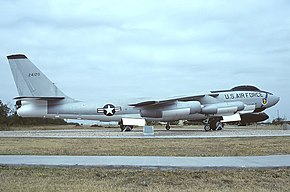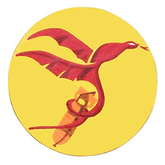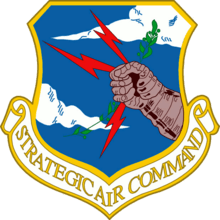339th Bombardment Squadron
The 339th Bombardment Squadron is an inactive United States Air Force unit. Its was last assigned to the 96th Bombardment Wing, stationed at Dyess Air Force Base, Texas, where it was inactivated on 15 March 1963.
| 339th Combat Crew Training Squadron | |
|---|---|
 B-47 Stratojet in 96th Bombardment Wing markings | |
| Active | 1942–1945; 1947–1949; 1953–1963 |
| Country | |
| Branch | |
| Role | medium bomber |
| Engagements | European Theater of Operations[1] |
| Decorations | Distinguished Unit Citation Air Force Outstanding Unit Award[1] |
| Insignia | |
| 339th Bombardment Squadron emblem (approved 27 October 1942)[1] |  |
History
World War II
Established as a B-17 Flying Fortress heavy bomber squadron; trained under Second Air Force. Deployed to European Theater of Operations (ETO), assigned to VIII Bomber Command in England, Flew combat missions over Nazi Germany and Occupied Europe until the German capitulation in May 1945.
Reserve operations
Activated as a reserve B-29 Superfortress squadron, 1947. Not equipped or manned; inactivated due to budget reductions, 1949.
Strategic Air Command
Reactivated in 1953 as a Strategic Air Command B-47 Stratojet squadron. Performed global deployments and training until inactivated in 1963. With the phaseout of the B-47 the training aircraft sent to storage at Davis–Monthan and the squadron was inactivated.
Lineage
- Constituted as the 339th Bombardment Squadron (Heavy) on 28 January 1942
- Activated on 15 July 1942
- Redesignated 339th Bombardment Squadron, Heavy on c. 21 June 1943
- Inactivated on 19 December 1945
- Redesignated 339th Bombardment Squadron, Very Heavy on 13 May 1947
- Activated in the reserve on 29 May 1947
- Inactivated on 27 June 1949
- Redesignated 339th Bombardment Squadron, Medium on 6 November 1953
- Activated on 18 November 1953
- Inactivated on 15 March 1963[1]
Assignments
- 96th Bombardment Group, 15 July 1942 – 15 December 1945
- 96th Bombardment Group, 29 May 1947
- 384th Bombardment Group, 8 October 1947 – 27 June 1949
- 96th Bombardment Wing (later 96th Strategic Aerospace) Wing), 18 November 1953 – 15 March 1963[1]
Stations
|
|
Aircraft
- Boeing B-17 Flying Fortress, 1943–1945
- Boeing B-47 Stratojet, 1955–1963[1]
References
Notes
- Maurer, Combat Squadrons, pp. 419-420
- Station number in Anderson
- Station information in Maurer, Combat Squadrons, pp. 419-420, except as noted.
Bibliography
![]()
- Anderson, Capt. Barry (1985). Army Air Forces Stations: A Guide to the Stations Where U.S. Army Air Forces Personnel Served in the United Kingdom During World War II (PDF). Maxwell AFB, AL: Research Division, USAF Historical Research Center. Archived from the original (PDF) on 23 January 2016. Retrieved 28 June 2017.
- Maurer, Maurer, ed. (1983) [1961]. Air Force Combat Units of World War II (PDF) (reprint ed.). Washington, DC: Office of Air Force History. ISBN 0-912799-02-1. LCCN 61060979. Retrieved 17 December 2016.
- Maurer, Maurer, ed. (1982) [1969]. Combat Squadrons of the Air Force, World War II (PDF) (reprint ed.). Washington, DC: Office of Air Force History. ISBN 0-405-12194-6. LCCN 70605402. OCLC 72556.
- Ravenstein, Charles A. (1984). Air Force Combat Wings, Lineage & Honors Histories 1947-1977 (PDF). Washington, DC: Office of Air Force History. ISBN 0-912799-12-9. Retrieved 17 December 2016.

